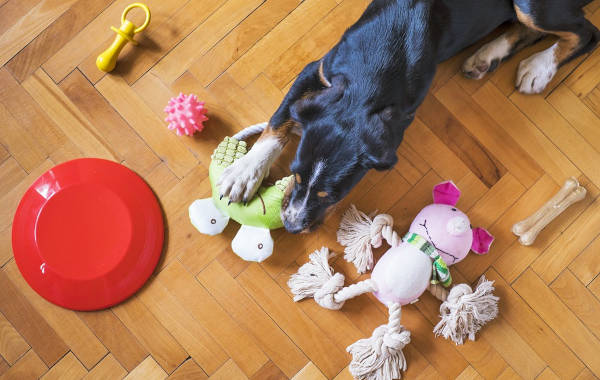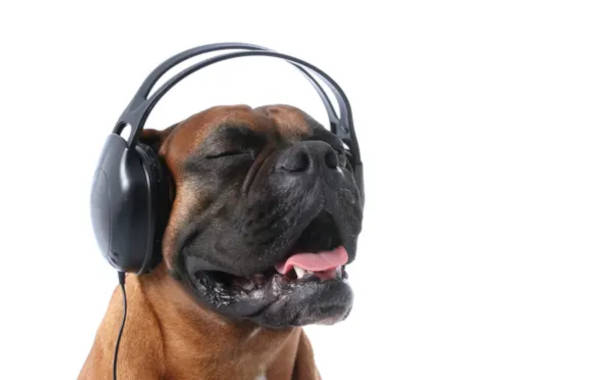5 Simple Tips for a Happy Dog Even While You’re at Work
Your furry friends are at their happiest when they’re around you. They’re always lying next to you, wagging their tails, or trying to play with you. They’re so used to your presence that watching you go to work every morning could dampen their mood.
And waiting for you to walk through the door is their happiest moment. Check out Yodi’s reaction when he sees his mom come home from work.

Unfortunately, your boss won’t accept the “my dog is home alone” excuse to give you the day off. The trick is to find ways to keep your pup entertained without you being around them all day. The methods you choose for maintaining a happy dog should do at least one of the following:
- Stimulate them mentally
- Improve their physical health
- Keep them entertained
- Ease their separation anxiety
- Improve their behavior
Keeping a happy dog is as easy as understanding its behaviors. You can then choose methods that are specific to them. Here are my five tips for keeping your canine happy while at work:
1. Get Your Dogs Some Interactive Toys

Toys keep your pet mentally and physically stimulated. They also tire them out, ensuring that your furry friend can sleep through a huge chunk of the day. There are many interactive dog toys to choose from, including:
- Chew toys
- Puzzle toys
- Tug toys
- Squeaker toys
- Treat dispensing toys
Since you’re choosing a toy your dog will play with without supervision, be sure to pick a safe one—avoid those that pose choking hazards.
Even more important, consider the environment and conditions in which your dog will be playing with the toys. Does the area environment provide enough space to play around with that specific toy? Will your dog break glass around the play area?
Be sure to pick a toy that also factors in any disability they have. For instance, there are plenty of toys for blind dogs you can choose from if your pooch can’t see.
Lastly, make sure your toy of choice aligns with your dog’s play style. This decision increases the amount of engagement your pup can get from a single toy. Most dogs I’ve interacted with have one of the following playstyles:
Tugging and Chewing
If your dog is often gnawing on your furniture and shoes, get them chewing toys. Ideally, look for durable models that won’t break down after a few days of use. Besides ensuring the safety of your furry friend, you’ll get to save yourself from making multiple trips to the pet store.
Self-Playing
This is your dog’s playstyle if they’re always playing by themselves. The ideal toys will be something that can keep them entertained while alone. Some good examples are treat-releasing puzzle toys and hide-and-seek plush toys.
Chasing
This is for dogs that love chasing toys, people, or other hounds around. Look for toys that your pup can throw around and chase. Alternatively, get ones that automatically throw objects for your dog to fetch. Be sure to give your pooch enough space to run around.
Seniors’ Play Style
Old dogs tend to avoid moving around, but this can be detrimental to their health. They can become obese and even develop movement disorders if they fail to exercise enough. Look for pet toys that encourage your senior dogs to get up and wander around, however minimal the movement is.
2. Create a Playlist for Your Happy Dog

Did you know that you might have the same music taste as your dog? A recent study showed that music could help pups at animal shelters relax. Music therapy can reduce the production of the stress hormone cortisol, reduce barking, and lower respiration rates. Music also helps drown outdoor noise that could aggravate your pooch.
[irp posts=”8147″ name=”A Musician’s Gift To Shelter Pups Goes Beyond Words”]
If you need to leave your dog happy at home, consider creating a playlist it can enjoy throughout the day. Choose music with soft tunes, a catchy rhythm, and a relaxing appeal.
Some of the best genres to consider are reggae, soft rock, and classical music. Since dogs tend to have more sensitive hearing than humans, be sure to avoid high-frequency music.
On the other paw, be sure to mix different genres. Your dog might get used to a specific genre of music to the point where it can no longer calm them down. If you’re looking for inspiration, here’s how Gnash created music that his dog enjoys:
The positive thing is that you don’t have to handpick your pupper’s music from scratch. There are multiple dog-targeted playlists online. Find one that makes your dog happy on YouTube or Spotify. Best of all, some last up to 15 hours, giving you plenty of music to play for your dog while you’re out.
3. Get Your Furry Friend a Dog Walker

Walking your dog helps it get rid of pent-up energy. Otherwise, it might focus this energy towards negative behaviors such as chewing on furniture.
“There are so many under-exercised and under-entertained dogs and that’s resulting in medical and destructive behavioral problems.”
– Dr. Kat Miller, an animal behaviorist and the ASPCA’s director of anti-cruelty behavior research
Walking your dog often could benefit it by:
- Improving its mental stimulation.
- Helping it exercise.
- Helping it socialize with its immediate environment.
- Acting as a training opportunity for eliminating some of your dog’s unwanted behavior.
Since you might not have the time to walk your pup, why not hire someone to do it for you? This way, you won’t have to worry about your dog-walking hours eating into your working hours. Dog walkers can also double as trainers for your pet and help you eliminate unwanted behavior like social anxiety and incessant barking.
You should ideally walk your dog for 30 minutes to two hours daily, according to PetMD. However, the total amount of time you should spend walking your dog will depend on various factors, including their age, health, and exercise tolerance.
Most importantly, focus on your dog’s breed to understand how much exercise it needs. Certain breeds call for exercise sessions that go beyond a simple walk. Here’s a table representing how much exercise each dog breed needs:
| Low | Medium | High | Intense |
|
|
|
|
4. Monitor Your Dog Remotely


We love the Furbo. This clever device allows you to monitor your pet, talk to them and even throw a treat.
If you’re looking to get technical about the wellbeing of your furry friend, consider buying a few gadgets to help you monitor your home’s:
- Ventilation
- Humidity
- Temperatures
- CO2 levels
- Equipment failures (heating, air conditioning, and ventilation systems)
Some gadgets even allow you to make adjustments remotely. The trick is to invest in the right sensors for your home first. For instance, buying a smart thermostat not only allows you to monitor your home’s temperature but also adjust it to your dog’s needs.
Ideally, you should connect these gadgets to your phone. Whenever an anomaly occurs, you’ll get a notification to your phone, after which you can make the right adjustment.
Most importantly, ensure that you invest in a good remote video recorder. Since your pet is spending a lot of time alone, you might want to know what they’re doing and to monitor if they’re a happy dog when alone. Ideally, the video recorder should have a wide enough angle to help you see the majority of the places your dog spends time.
If you have a pooch that suffers from separation anxiety, consider purchasing speakers that allow you to talk to and soothe your pet too. The Furbo, pictured above, allows for two way communication. Use this opportunity to calm your dog whenever they seem anxious. The Furbo even comes with treat dispensers for rewarding your pooch for good behavior.
5. Treat Your Dog to Some Live Entertainment

Imagine spending the entire day staring at blank walls. Your dog is bound to get bored with the same view every day. Why not let your pup see the world from your window?
This plan gives them something different to watch every day. Of course, you might have to place a chair close to your window to ensure your dog reaches the window’s height. Be sure to close your windows to avoid your pet escaping.
Even more important, ensure your canine won’t act up after seeing strangers and pets strolling outside your window. If they aren’t yet used to watching people walking around, place them at windows that have fewer people wandering by.
Keep Your Dog Relaxed and Entertained
Nothing can replace the comfort your presence offers your dogs—but you need to train them to be happy even without you around. The tips above will make for a happy dog while ensuring their health and wellbeing.



